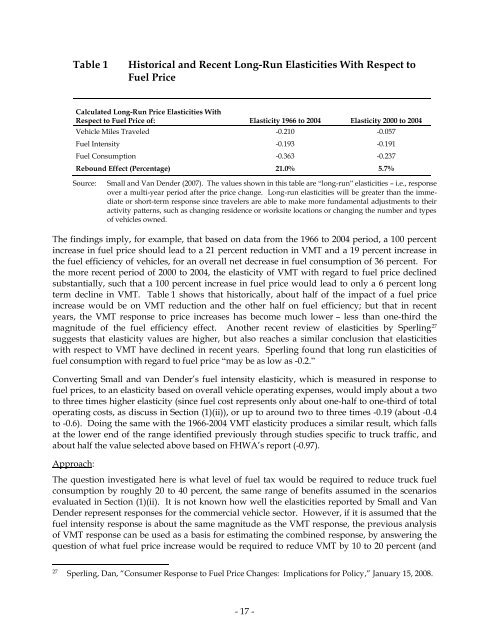Assessment of Fuel Economy Technologies for Medium and Heavy ...
Assessment of Fuel Economy Technologies for Medium and Heavy ...
Assessment of Fuel Economy Technologies for Medium and Heavy ...
Create successful ePaper yourself
Turn your PDF publications into a flip-book with our unique Google optimized e-Paper software.
Table 1<br />
Historical <strong>and</strong> Recent Long-Run Elasticities With Respect to<br />
<strong>Fuel</strong> Price<br />
Calculated Long-Run Price Elasticities With<br />
Respect to <strong>Fuel</strong> Price <strong>of</strong>: Elasticity 1966 to 2004 Elasticity 2000 to 2004<br />
Vehicle Miles Traveled -0.210 -0.057<br />
<strong>Fuel</strong> Intensity -0.193 -0.191<br />
<strong>Fuel</strong> Consumption -0.363 -0.237<br />
Rebound Effect (Percentage) 21.0% 5.7%<br />
Source:<br />
Small <strong>and</strong> Van Dender (2007). The values shown in this table are “long-run” elasticities – i.e., response<br />
over a multi-year period after the price change. Long-run elasticities will be greater than the immediate<br />
or short-term response since travelers are able to make more fundamental adjustments to their<br />
activity patterns, such as changing residence or worksite locations or changing the number <strong>and</strong> types<br />
<strong>of</strong> vehicles owned.<br />
The findings imply, <strong>for</strong> example, that based on data from the 1966 to 2004 period, a 100 percent<br />
increase in fuel price should lead to a 21 percent reduction in VMT <strong>and</strong> a 19 percent increase in<br />
the fuel efficiency <strong>of</strong> vehicles, <strong>for</strong> an overall net decrease in fuel consumption <strong>of</strong> 36 percent. For<br />
the more recent period <strong>of</strong> 2000 to 2004, the elasticity <strong>of</strong> VMT with regard to fuel price declined<br />
substantially, such that a 100 percent increase in fuel price would lead to only a 6 percent long<br />
term decline in VMT. Table 1 shows that historically, about half <strong>of</strong> the impact <strong>of</strong> a fuel price<br />
increase would be on VMT reduction <strong>and</strong> the other half on fuel efficiency; but that in recent<br />
years, the VMT response to price increases has become much lower – less than one-third the<br />
magnitude <strong>of</strong> the fuel efficiency effect. Another recent review <strong>of</strong> elasticities by Sperling 27<br />
suggests that elasticity values are higher, but also reaches a similar conclusion that elasticities<br />
with respect to VMT have declined in recent years. Sperling found that long run elasticities <strong>of</strong><br />
fuel consumption with regard to fuel price “may be as low as -0.2.”<br />
Converting Small <strong>and</strong> van Dender‘s fuel intensity elasticity, which is measured in response to<br />
fuel prices, to an elasticity based on overall vehicle operating expenses, would imply about a two<br />
to three times higher elasticity (since fuel cost represents only about one-half to one-third <strong>of</strong> total<br />
operating costs, as discuss in Section (1)(ii)), or up to around two to three times -0.19 (about -0.4<br />
to -0.6). Doing the same with the 1966-2004 VMT elasticity produces a similar result, which falls<br />
at the lower end <strong>of</strong> the range identified previously through studies specific to truck traffic, <strong>and</strong><br />
about half the value selected above based on FHWA‘s report (-0.97).<br />
Approach:<br />
The question investigated here is what level <strong>of</strong> fuel tax would be required to reduce truck fuel<br />
consumption by roughly 20 to 40 percent, the same range <strong>of</strong> benefits assumed in the scenarios<br />
evaluated in Section (1)(ii). It is not known how well the elasticities reported by Small <strong>and</strong> Van<br />
Dender represent responses <strong>for</strong> the commercial vehicle sector. However, if it is assumed that the<br />
fuel intensity response is about the same magnitude as the VMT response, the previous analysis<br />
<strong>of</strong> VMT response can be used as a basis <strong>for</strong> estimating the combined response, by answering the<br />
question <strong>of</strong> what fuel price increase would be required to reduce VMT by 10 to 20 percent (<strong>and</strong><br />
27<br />
Sperling, Dan, ―Consumer Response to <strong>Fuel</strong> Price Changes: Implications <strong>for</strong> Policy,‖ January 15, 2008.<br />
- 17 -
















